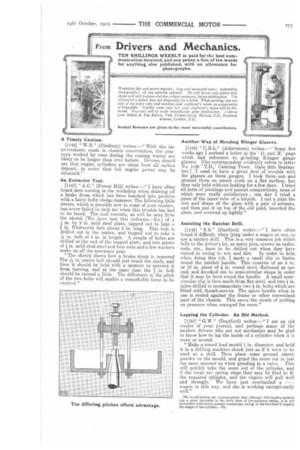From Drivers and Mechanics.
Page 21

If you've noticed an error in this article please click here to report it so we can fix it.
TEN SHILLINGS WEEKLY is paid for the best cotn. niunication received, and one penny a line of ten words for anything else published, with an allowance for photographs.
Workshop tips and smart retairs; long and successful runs; interesting Photographs all are suitable subjects. We will knock your letters into shake and will prepare sketches, where necessary, before Publication. The absence of a sketch does not disqualify for a prize. When WI iti7tg, use one side of the pater only and mention your employer's name as a guarantee of bona fides. Neither your own nor your employer's name will be disclosed. Payment will be made ionntediately after publication. A ddress your letters to The Editor, THE COMMERCIAL MOTOR, 7-15, Rosebery
Avenue, London, E.G.
A Timely Caution.
[1146] " W.B." (Finsbury) writes :—" With the improvements made in chassis construction, the journeys worked by vans during the coming winter are likely to be longer than ever before. Drivers should see that engine cylinders are clean from all carbon deposit, in. order that full engine power may be obtained."
An Extractor Tool.
[1147] " A.C." (Forest Hill) writes :—" I have often heard men cursing in the workshop when drawing off a brake drum which has been knocked into position with a fairly hefty sledge-hammer. The following little device, which is possibly new to some of your readers, has never failed to help me when this trouble has had to be faced. The tool consists, as will be seen from the sketch [We have had this redrawn.—Eol of a fi in. by 2 in. mild steel plate, tapped out to take a / in. Whitworth bolt about 2 in. long. This bolt, is drilled out in the centre, and tapped out to take a ir in. bolt of 4 in. in length. A couple of holes are drilled at the end of the tapped plate, and two pieces of in. mild stud steel and four nuts and a few washers make up all the necessary gear. "The sketch shows how a brake drum is removed The /Tr in. centre holt, should just touch the shaft, and then it should be held with a spanner to prevent it from turning, and at the same time the in. bolt should be turned a little. The difference in the pitch of the two bolts will enable a remarkable force to he exerted."
Another Way of Mending Klinger Glasses.
[1148] " C.B.L." (Atherstone) writes:—" Some few weeks ago I noticed a letter in the D. and M: page which had reference to grinding Klinger gauge glasses. [Our correspondent evidently refers to letter No. 1128 'T.D.,' Canning Town. Date 26th September.] I used to have a great deal of trouble with the glasses on these gauges. I took them out and ground them on emery cloth on a flat surface, but they only held without leaking for a few days. I tried all sorts of jointings and patent compositions, none of which were really satisfactory ; one day I tried a piece of the inner tube of a bicycle. I cut a joint the size and shape of the glass with a, pair of scissors, and then put it on top of the old joint, inserted the glass, and screwed up tightly."
Assisting the Ratchet Drill.
[1149] " S. S." (Dartford) writes :—" I have often found it difficult, when lying under a wagon or van, to use a ratchet drill. This is a very common job which falls to the driver's lot, as many pins, screws on radius rods, etc., have to be drilled out when they have rusted in owing to wet and dirt. In order to help when doing this job, I made a small clip to fasten round the ratchet handle. This consists of an 8 in. or 10 in. piece of it in. round steel, flattened at one end, and knocked out to semi-circular shape in order that it may be bent round the handle. A small semicircular clip is then made from flat steel, and two + in. holes drilled to accommodate two / in. bolts which are fitted with thumb-screws. The spare handle when in use is rested against the frame or other convenient part of the chassis. This saves the strain of putting on pressure when cramped for room."
Lapping the Cylinder. An Old Method.
[1150] " G.W." (Deptford) writes :—" I am an old reader of your journal, and perhaps many of the modern drivers who are not mechanics may be glad to know how to lap the inside of a cylinder when it is worn or scored.
"Make a round lead mould 1 in. diameter, and hold it in a, drilling machine chuck just as if it were to be used as a drill. Then place some ground emery powder on the mould, and grind the score out in just the same manner as when grinding in a valve. This will quickly take the score out of the cylinder, and if the rings are spring rings they may he filed to fit the repaired cylinder, and the engine will pull well and strongly. We have just overhauled a wagon in this way, and she is working exceptionally well."
[We would inform oar correspondent that althongh this lapping method was a great favourite in the early days of low-pressure steam, it is not favonrahly received in modern workshops, owir.g to the fact that it impairs the shape of the cylinder,—Ep,






















